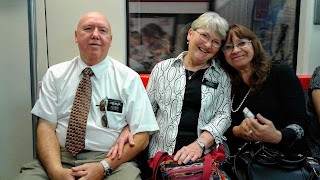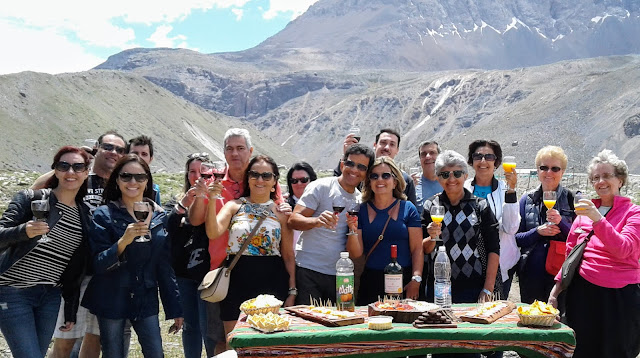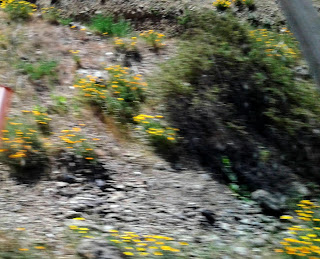 |
| Sister Phillips and her new companion |
conference (held twice a year) and the annual temple workers' devotional on Sunday.
 |
| Claudia and her little boys have been friends but are sadly moving to another part of Santiago. |
 |
| We took the metro along with Elders Lloyd and Beck serving in our Pocuro ward. |
 |
| Some go up the hard and steep way. The bikers arrived after we had walked around and were having our snack. |
 |
| Water from this reservoir provides 60% of Santiago's water |
 |
| The fresh clean cool air and breeze felt wonderful! I could have stayed a lot longer. Sister Umber agreed! |
 |
| As we walked along the road we had to step to the edge to let many trucks of gypsum pass. |
 |
| Falls just below the dam, where we stopped to have a snack. |
There are apparently a lot of animals (pumas, llamas, vicunas, condors, etc.) up here, but unfortunately we only saw lots of small colorful birds.
Santiaguinos Mauricio (driver) and Gonzalo (guide) spread out some snacks, and then after eating, we zoomed back down the canyon, enjoying some waterfalls and more gorgeous scenery, which I always think I can capture, but which usually turns out blurry.
 |
| Orange-juice drinkers on the right. Some of us didn't save our appetite for lunch in San Jose de Maipo, small town down the mountain. |
 |
| I wonder about the volume of water needed to supply 60% of Santiago's water! I usually buy bottled water, though, as tap water (though safe) tastes like it contains too many metals and minerals |

 |
| School's original building with extension behind. Children must be brought in from a large area, as this is a very small town. |
 |
| As at many schools there is mural with Gabriela Mistral declaring the importance of education, that "the future of children is today" |
 |
| Most of the buildings are of adobe |
the very human "Stories of the (Panama) Canal", as presented by 5 directors, showing different eras of the Canal, from before its inauguration in 1915 to the present day. The protagonists are the North American (US), Panamanian and other men,women and children of the region (Antilles) who helped build and were greatly impacted by it in many different ways. 27,000 died in the building, by malaria, accidents, racist violence, and more.
I also recommend a delightful/intriguing memoir by (at the time a child and young woman) Hildegarde Mahoney, called: Journey interrupted: A Family without a Country in a World at War about her Americanized German family living in NYC (which they love and consider home and where her two brothers were born) who are interrupted in their travels back to Germany to visit grandparents (they wanted to make the trip across US, Pacific, Russia, etc. more of an adventure), but get stuck for 4+ years in Japan as WWII breaks out, living a tough life in an enclave for foreigners, as some are suspected of spying. Then, as the war ends they are sent back to Germany by General MacArthur as the parents and author are German citizens. The parents' resilience, perseverance, resourcefulness, friendliness and strong family bonds are truly inspiring as they strive to return to the U.S.
I love to watch the excitement of my students as they learn English. I love to see the pride of little children as they learn a new song or skill. I hope we all feel joy as we discover new interests, meet new people from different cultures and backgrounds, develop our talents, and especially as we gain greater understanding of spiritual things. After all, we are all still children in God's eyes!






























Awww the poppies!!! I agree with ice cream over lunch with the heat here!
ReplyDelete